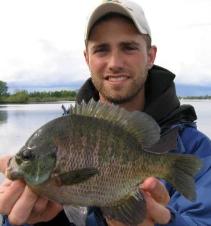The Spring Panfish Formula

As anglers we find ourselves needing a
reason for the decisions we make. We need
to justify that the decisions we make will have
a positive outcome on our day of fishing.
Let’s face it; we don’t want to make decisions
that result in a poor day of fishing. So we
analyze the situation and make the best
decision based on the given conditions. We
start to build a pattern and then execute that
pattern. Right or wrong, we tell ourselves—
through our gut instincts—that these specific
moves will help us catch more fish.
Sometimes we turn towards our network of fishing buddies to help guide us,
other times we just wing-it and hope for the best, but regardless of path we still
try to use our best judgment to gain the desired outcome. With panfish, we
oftentimes over-analyze the situation and make the decisions tougher than they
need to be. With panfish there are simple formulas for success, especially
during the spring.
Let temperature be your guide. If I had to pick one season where
temperature plays the most crucial role then it would be spring. Fish are coming
off the coldest water temps of the year and they are desperate to find the
warmest water possible. Even small variations in water temperature can make
huge changes in fish behavior and location. Trying to find the warmest water
possible can be one of the easiest steps to spring-time success. Look for areas
that receive the most impact from the sun—namely the north and northwest
portions of the body of water you’re fishing. These areas receive the most
sunlight and will typically warm up the fastest. Channels, creek arms, back bays,
these are just a few of the areas to target. Pay attention to your electronics and
see if there is an increase in temperature as you move into these areas.
Panfish will look for these spots to seek comfort in the slightly warmer water.
Don’t put away the ice fishing tackle. I’m sure you think I’m crazy with that
statement, but I’m actually directing that towards the presentations you use for
ice fishing. Early spring panfish are still trying to build-up their stomachs and
their mindset is still on smaller morsels of food. They are used to feeding on
insects, plankton and other tiny offerings from the long winter months. A big
mistake I see many early spring panfish anglers make is to throw something too
large at the fish. Keep your small ice jigs and ice plastics handy and give those
a shot, even the largest panfish in the lake will still take a pass at the ice jigs
once the lakes open up. If you need to, fish them under a float, especially up
against the warm banks and back channels.
It’s not always good to be fast. This is in reference to the speed of your
presentation. Much-like ice fishing, there are times where we need to finesse
spring-time panfish. Early spring is not always the best time to burn a small
spinnerbait or snap a twister tail; instead you want to glide an enticing plastic in
front of the fish’s face, offering them an easy meal. Make it easy on the fish and
focus more on presenting the bait in the strike zone rather than fan-casting an
area at high-velocity. If using a float system, let the presentation sit for a
second or two in between movements, or slowly retrieve the bait under a float.
Think of it as force-feeding the fish, make it easy on them.
Be willing to adapt. As we know, weather during the spring season can be a
lot of fun. One day it’s sunny and calm, the next day it’s rainy and windy. We
can’t control the weather, so be willing to adapt and adjust to the weather
conditions. Have a drift-sock with you in your boat or even an anchor. Spring-
time panfish typically won’t make huge moves within a given day, so if you find a
pod of fish you will want to have the means to stay over them. Hunkering down
and focusing in on a school of fish can be half-the-battle during certain
conditions, so be ready for the weather to throw a wide-variety of conditions
your way.
Focus small, and then make big moves. What the heck does this mean you
ask? With spring-time panfish, you don’t need to make multiple small moves to
find the spot-on-the-spot. If you run up into a creek arm or channel and fish the
warmest part and find no fish, then move out completely. No need to fish your
way in and out because if they are not snapping in the “hot zone” then it’s
usually safe to say they are not using that arm, channel or bay at that particular
time. If this happens, then bolt out and hit an entirely new arm, channel or bay
and repeat the process. You might find five different channels, all with 50-
degree water temp and all on the same side of the lake, but only one of them
holds fish. It’s a weird scenario but it happens. No need to beat up “dead”
water, get out and move onto the next spot.
Go ahead and sleep-in. This is intended for one reason—waiting for the sun
to get high and warm-up those north and west banks. Spring is one of those
rare situations where mid-day and afternoon bites can be the most productive.
Now, I’m not saying you won’t find a productive morning bite, but typically you’re
fishing deeper structure for the active morning bite. The shallow, warmer water
generally needs some time to warm-up. If you want to get an early start on the
day then try focusing on weed lines or basin areas—places where you found
fish at late ice. Then once the sun has the chance to reach its full potential you
can move back into the bay, arm or channel in search of your warm-water fish.
We all get excited to get the boat out once the ice melts, but using summer-time
tactics doesn’t always pay off when the water temps are cold. Use a few of
these tips when you venture out chasing early spring panfish this season and
even though the water and air temps are cold, the fishing can still be hot!
Good Fishin,
Matt Johnson
